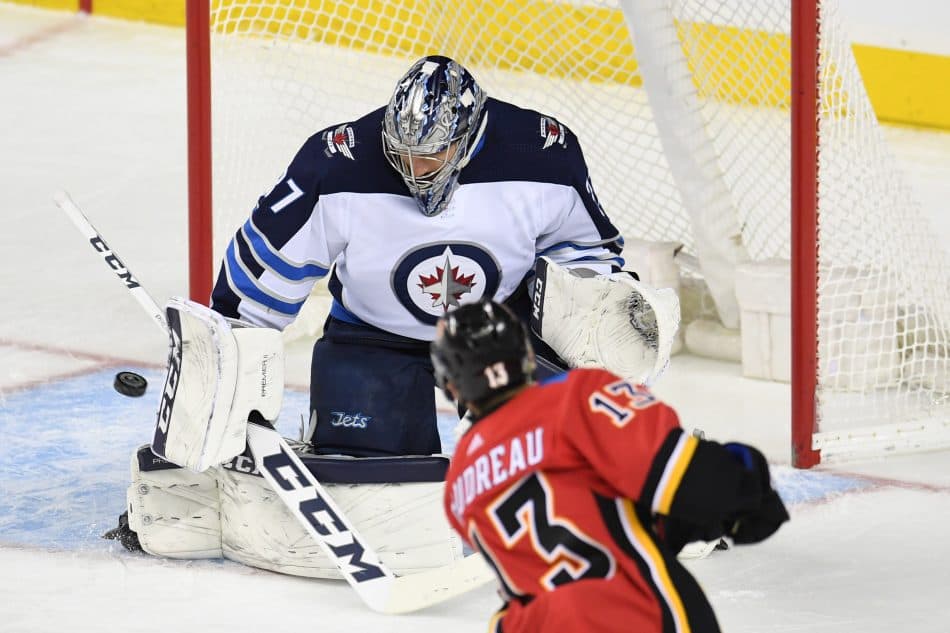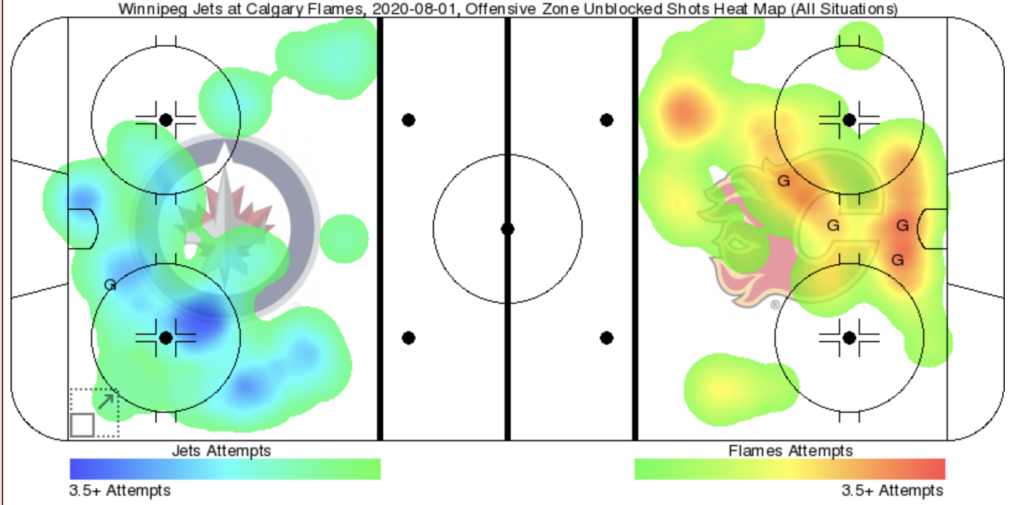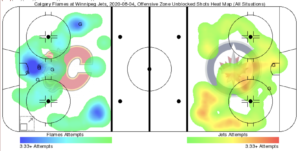Winning the series means controlling the slot for the Flames

By Craig Petter
3 years agoEveryone knows that the slot is the most lucrative piece of real estate in the offensive zone, right?
Trace two parallel lines between the inside curve of either face-off dot, link them with horizontals at the top of the crease and the second hashmark, and presto—you have a rectangular sweet spot of pure demolition. Rebounds trickle into it, wingers boom one-timers from its heart, wary third forwards intercept passes and thwart breakouts from its edges. Novice hockey players learn to buzz around the slot for easy finishes before they can even lace up their own skates. If you want to score, shoot from there.
But the Calgary Flames and the Winnipeg Jets have alternately forgotten that fundamental rule over the first three games of their Qualifying Round series. In every game so far, the victor has dominated the lower slot while the vanquished has languished (see what I did there) in that area.
Upon inspection of the shot-location maps (below) from each game so far this series, the majority of the goals scored by the winning sides have been concentrated in the slot while losing teams scrounge for their tallies on the fringes. As expected. Goals spring from high-danger slabs of ice.
But even more noteworthy than that is the fact that the winning team consistently generates way more shot attempts from the lower slot, too. In Games 1/2/3 the Jets, the Flames, and the Jets respectively failed to make any noise in the loudest area of the ice and lost those games. The area of densest shots for them was never the slot, but more obscure and trackable locations. Meanwhile, the winners not only score from the slot but post the brunt of their unconverted shots there, too. Implying a stronger forecheck, crisper passes, smarter powerplay and better team to boot, since snipes from the slots are rarely flukes. Teams penetrate the slot by crafting, executing their own plays—not just piggybacking on the errors of others (ahem, Game 2 Flames).
The heatmaps below (accounting for all game situations, courtesy of NaturalStatTrick) say it best. Darker splotches signify an onslaught of shot attempts within that precise radius, lighter areas correlate to fewer tries from those streaks, Gs mean goals (obviously).
Game 1: Flames own the house

Three of the Flames’ four goals notched from the slot, and the richest red localized in the most lethal lower areas. The Flames made a point to breach the Jets’ box, and it paid off. This game especially showcased an effective power play, as the Flames’ presence in the lower slot gifts them their first goal: see Sean Monahan occupy the spot, pounce on the puck and feed Johnny Gaudreau.
And the Flames protected their own slot admirably, too. The deepest blue pinpoints how the Jets scored their goal outside the sweet spot and flung most of their shot attempts from a further distance and indirect angle. Greater distance gave Cam Talbot more time to react and the Flames defence more space to clog shooting/passing lanes, the indirect angle limits the amount of twine shooters can see. The Flames shuttered their window, stifled the Jets’ breeze, and won the game.
Game 2: Jets short the market

Look at that puddle of blue. The Jets infiltrated an area they could not touch the game before and posted all three of their goals within the same sliver of space. Their second goal highlights how scoring from the slot is frequently a symptom of overall better play, too. The Jets cycle, pinch, and pass perfectly as to fatten gaps in the offensive zone and tangle the Flames all together in front, isolating Adam Lowry for an easy rebound (first clip).
Meanwhile, the Flames barely register an attempt from the lower slot. Zero shades of red flushing the most potent area of the ice. Instead, the Flames lofted all their shots from the top of the circle—this betrays a blatant lack of killer instinct, as no rebounds jump that far and no cross-crease passes stray that high. If memory serves, most of those shots were simply floated on the rush and smothered by Connor Hellebuyck. No wonder their goals were all goofs on the Jets’ side of things (from behind the net? really?)— their attempts lacked creativity, and they lost.
Game 3: Flames reclaim the property

But the resurgence was beautiful. The Flames wear the blue on the map this time and pull it off with ease. Overlapping G’s swarming a slot swimming in indigo, and both even-strength markers with Hellebuyck in net resulting from the relentless forecheck of workhorse Andrew Mangiapane:
And also:
Meanwhile, the Jets manage as many shot attempts from the high-percentage slot as the empty-prayer right corner of the blueline. The Flames guarded their box as well as they have all series, due in part to their discipline. Suffering only two penalties all game, the Flames refused to grant the Jets too many chances to march into their house (and thank goodness, since they converted on the power play when Andrew Copp swooped right in there). Meanwhile, the Flames lodged two power play markers thanks to power play creativity, players dancing through the slot, opening themselves to passes, securing the win.
Essentially, in this series, the team that roars down the highway wins, and the team that putters around the ditch loses. Period. To nab Game 4 (and the series by consequence), the Flames need to funnel all their forechecking, cycling and power-play resources towards firing from that rectangular sweet spot.
Recent articles from Craig Petter





